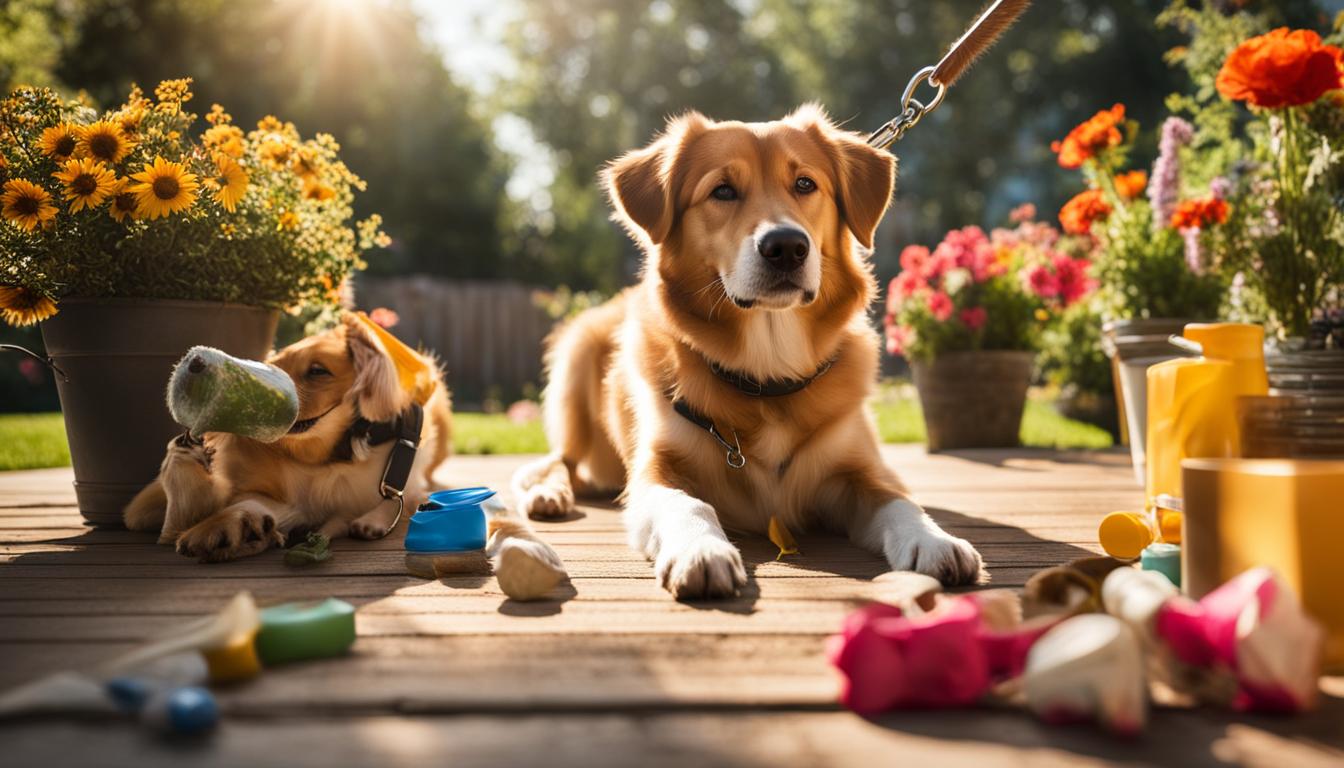Dogs are more than just pets; they are beloved members of our families. To ensure their health and well-being, it’s important to master the basics of dog care. In this comprehensive guide, we will cover the essential aspects of dog care, including grooming, training, exercise, and nutrition. By following these tips, you can ensure that your furry friend is happy and healthy.
- The Importance of Grooming for Your Dog's Health and Well-being
- Training Your Dog for Good Behavior
- Feeding Your Dog for Optimal Nutrition
- Exercise: Keeping Your Dog Active and Fit
- Understanding and Managing Dog Behavior
- Keeping Your Dog's Teeth and Gums Healthy
- Ensuring Your Dog's Emotional Well-being
- Maintaining a Safe and Clean Environment for Your Dog
- Conclusion
- FAQ
- Source Links
Key Takeaways
- Understanding the basics of dog care is essential for the health and well-being of your pet.
- Grooming plays a vital role in maintaining your dog’s overall health and preventing skin issues.
- Training helps establish good behavior and strengthens the bond between you and your dog.
- Feeding your dog a balanced and nutritious diet is crucial for their overall health.
- Regular exercise keeps your dog physically and mentally fit.
The Importance of Grooming for Your Dog’s Health and Well-being
Grooming is an essential part of maintaining your dog’s overall health and well-being. Regular grooming not only keeps your dog looking their best but also plays a vital role in preventing skin issues, matting, and infections. By taking the time to groom your dog properly, you can ensure that they remain clean, comfortable, and happy.
Before you begin the grooming process, gather all the necessary tools and supplies. Having everything ready beforehand will make the process smoother and more efficient. Make sure you have dog shampoo, conditioner, brushes, nail clippers, ear cleaner, towels, and a blow dryer. By being prepared, you can create a positive and stress-free grooming experience for your furry friend.
When it comes to grooming, it’s important to establish a positive association for your dog. Offer treats and praise throughout the process to make it an enjoyable experience. Start by bathing your dog, being careful to use dog-specific shampoo and conditioner. Take your time to dry their coat thoroughly, ensuring they are comfortable and warm. Brush their fur gently, removing any tangles or mats. Finally, trim their nails and clean their ears regularly to prevent any issues.
Benefits of Regular Grooming:
- Prevents skin issues and infections
- Reduces shedding and matting
- Keeps coat clean and healthy
- Prevents painful nail overgrowth
- Ensures proper ear hygiene
By maintaining a consistent grooming routine, you are not only caring for your dog’s physical appearance but also prioritizing their health and well-being. Regular grooming sessions provide an opportunity for you to bond with your dog and ensure their overall happiness. Remember to approach grooming with patience, love, and positive reinforcement to create a positive experience for your furry friend.
Training Your Dog for Good Behavior
Training is an essential part of responsible dog ownership. It not only helps your dog develop good behavior but also strengthens the bond between you and your furry friend. By investing time and effort into training, you can set clear boundaries, teach commands, and address any behavioral issues that may arise.
Positive Reinforcement
One of the most effective training techniques is positive reinforcement. This involves rewarding your dog for exhibiting desired behaviors with treats, praise, or affection. By associating good behavior with positive outcomes, your dog will be motivated to repeat these actions. When training, be patient and consistent, and remember to use positive reinforcement to encourage good behavior.
Basic Commands
Teaching your dog basic commands is an important part of their training. Commands like sit, stay, come, and leave it can help you maintain control in various situations. Start with one command at a time, using treats and praise as rewards for correctly following instructions. Repeat the command consistently and practice in different environments to reinforce the command’s meaning to your dog.
| Command | Description |
|---|---|
| Sit | Teaches your dog to sit on command. |
| Stay | Teaches your dog to stay in one place until released. |
| Come | Teaches your dog to come to you when called. |
| Leave it | Teaches your dog to ignore objects or food on the ground. |
Professional Guidance
If you’re struggling with training or need additional support, consider enrolling your dog in obedience classes or working with a professional dog trainer. These experts can provide guidance, specialized techniques, and personalized strategies to address specific training needs. They can also help you navigate any challenges or behavioral issues that may arise during the training process.
Remember, training is an ongoing process that requires patience, consistency, and positive reinforcement. By investing time and effort into training your dog, you can set them up for a lifetime of good behavior and a harmonious relationship with you and your family.
Feeding Your Dog for Optimal Nutrition
When it comes to keeping your dog healthy, proper nutrition plays a crucial role. Feeding your dog a balanced and nutritious diet is essential for their overall well-being and longevity. By providing them with the right nutrients, you can ensure that they have the energy they need to thrive and maintain a strong immune system.
Start by choosing high-quality dog food that is specifically formulated for your dog’s age, size, and activity level. Look for options that have real meat as the first ingredient and are free from artificial additives and fillers. The packaging will usually provide feeding guidelines, but it’s important to remember that these are just a starting point. Every dog is unique, and their individual metabolism and energy requirements may vary.
Monitor your dog’s weight and body condition regularly to ensure they are receiving the appropriate amount of food. Adjust their portion sizes as needed to maintain a healthy weight. If you’re unsure about how much to feed your dog, consult with your veterinarian for personalized recommendations.
| Nutrient | Recommended Amount |
|---|---|
| Protein | 18-25% |
| Fat | 10-15% |
| Carbohydrates | 30-70% |
| Fiber | 2-5% |
| Calcium | 0.5-1% |
| Phosphorus | 0.4-0.8% |
| Omega-3 Fatty Acids | 0.5-2.5% |
| Omega-6 Fatty Acids | 2-4% |
It’s also important to avoid feeding your dog table scraps or foods that are toxic to dogs. Some common foods to avoid include chocolate, grapes, onions, and garlic. These foods can be harmful and may cause serious health issues for your furry friend.
Remember, a healthy diet is just one part of providing optimal nutrition for your dog. Access to fresh water at all times is also essential. Regular exercise, mental stimulation, and regular veterinary check-ups are equally important in maintaining your dog’s overall health and well-being. By taking a holistic approach to your dog’s care, you can ensure they live a long, happy, and healthy life.
Exercise: Keeping Your Dog Active and Fit
Regular exercise is essential for maintaining your dog’s physical and mental well-being. Not only does exercise help keep them active and fit, but it also promotes a healthy weight, strengthens their muscles and bones, and improves their cardiovascular health. Engaging in regular physical activity with your dog will also strengthen the bond between you and provide opportunities for socialization.
When it comes to exercise, it’s important to consider factors such as your dog’s age, breed, size, and overall health. A young and energetic dog may require more vigorous exercise, such as running or playing fetch, while an older dog may benefit from gentler activities like leisurely walks or swimming. It’s important to tailor the exercise routine to your dog’s individual needs and abilities.
To keep your dog active and fit, aim for at least 30 minutes to 1 hour of exercise every day. This can be divided into multiple shorter sessions throughout the day. Incorporate different types of activities to keep your dog mentally stimulated and prevent boredom. Some ideas include brisk walks, hikes, agility training, interactive play sessions, and visits to dog parks.
| Activity | Duration | Benefits |
|---|---|---|
| Brisk Walks | 30 minutes | Improves cardiovascular health and maintains a healthy weight |
| Hiking | 1-2 hours | Provides mental stimulation and strengthens muscles |
| Agility Training | 20-30 minutes | Enhances coordination, focus, and agility |
| Interactive Play Sessions | 15-20 minutes | Promotes bonding and stimulates the mind |
| Dog Park Visits | 30-60 minutes | Provides socialization opportunities and allows for off-leash exercise |
Remember to always prioritize your dog’s safety during exercise. Ensure that your dog is properly hydrated, especially in hot weather, and be mindful of their limits. Avoid overexertion, especially in extreme temperatures, as dogs can easily overheat. Familiarize yourself with the signs of heatstroke and take breaks as needed. Additionally, keep your dog on a leash in public areas and follow local regulations for off-leash activities.
By keeping your dog active and fit, you are not only contributing to their physical health but also their overall happiness and well-being. Regular exercise will help prevent behavioral problems caused by excess energy and provide a positive outlet for their natural instincts. So grab your leash and enjoy some quality time with your furry friend!
Exercise Tips:
- Vary the activities to keep your dog mentally stimulated and prevent boredom.
- Consider your dog’s age, breed, size, and health when determining the appropriate amount and type of exercise.
- Stay hydrated and take breaks as needed, especially in hot weather.
- Be mindful of your dog’s limits to avoid overexertion and injury.
- Always prioritize your dog’s safety and follow local regulations for off-leash activities.
Understanding and Managing Dog Behavior

Dogs have unique behaviors and understanding them is crucial for building a strong bond and addressing any behavioral issues that may arise. By recognizing common behaviors and their underlying causes, you can effectively manage your dog’s behavior and ensure their well-being.
Common Dog Behaviors
Here are some common dog behaviors and possible explanations:
- Barking: Dogs bark to communicate their needs, express fear or excitement, or to protect their territory.
- Chewing: Dogs may chew to alleviate teething discomfort, relieve stress or boredom, or explore their environment.
- Digging: Dogs dig to bury or retrieve things, escape confinement, create a den, or simply because it’s instinctual.
Managing Unwanted Behaviors
To discourage unwanted behaviors and reinforce positive ones, use positive reinforcement techniques:
- Redirect: When your dog engages in an unwanted behavior, redirect their attention to a more appropriate activity or toy.
- Positive reinforcement: Reward desired behaviors with treats, praise, or play to encourage them to repeat those behaviors.
- Consistency: Establish consistent rules and expectations for your dog, and enforce them consistently to avoid confusion.
Remember, punishment or negative reinforcement can harm the bond between you and your dog and may lead to fear or aggression.
Mental Stimulation and Training
Dogs need mental stimulation to prevent boredom and associated behavior problems. Engage your dog’s mind through interactive toys, puzzle games, and obedience training. Mental exercise can tire your dog out as much as physical exercise, contributing to their overall well-being.
Seeking Professional Support
If you’re struggling with managing your dog’s behavior, don’t hesitate to seek professional help. A professional dog trainer or behaviorist can provide guidance and support tailored to your dog’s specific needs. They can assist you in addressing behavioral issues and developing a personalized training plan.
Keeping Your Dog’s Teeth and Gums Healthy
Maintaining good dental care for your dog is essential for their overall health and well-being. Just like humans, dogs can suffer from dental issues such as plaque buildup, gum disease, and tooth decay. By implementing a regular dental care routine, you can help ensure that your furry friend has healthy teeth and gums, preventing potential pain and discomfort.
One of the key components of dog dental care is brushing their teeth regularly. Use a dog-specific toothbrush and toothpaste to gently clean your dog’s teeth and gums. Start by introducing the toothbrush and toothpaste gradually, allowing your dog to become familiar with the process. Begin by applying a small amount of toothpaste to your finger and let your dog lick it off. Once they are comfortable with the taste, introduce the toothbrush and gently brush their teeth in a circular motion.
“Regular dental care is crucial for your dog’s oral hygiene. Brushing their teeth on a daily basis helps remove plaque and prevents tartar buildup.”
In addition to brushing, there are other dental care options for your dog. Dental chews and toys can help promote healthy teeth and gums by massaging the gums and removing plaque. Be sure to choose dental chews that are appropriate for your dog’s size and provide a safe chewing experience. Regular veterinary check-ups are also important to assess your dog’s dental health and determine if a professional dental cleaning is needed.
Table: Dog Dental Care Products
| Product | Description |
|---|---|
| Dog Toothbrush | A toothbrush specifically designed for dogs with soft bristles to gently clean their teeth and gums. |
| Dog Toothpaste | Dog-friendly toothpaste with flavors they enjoy, such as poultry or beef, to make brushing more enjoyable. |
| Dental Chews | Chews designed to promote dental health by reducing plaque and tartar buildup through chewing. |
| Dental Toys | Toys that help massage the gums and clean teeth while providing entertainment for your dog. |
By prioritizing your dog’s dental care, you can help maintain their oral hygiene and prevent dental issues. Remember to establish a regular dental care routine, provide appropriate dental products, and seek professional veterinary care when necessary. With proper care, your dog can enjoy a lifetime of healthy teeth and gums.
Ensuring Your Dog’s Emotional Well-being
As a responsible dog owner, it’s essential to prioritize your furry friend’s emotional well-being. Dogs, like humans, have emotional needs that must be met to ensure their overall happiness and contentment. By providing mental stimulation, fulfilling their emotional needs, and creating a safe and nurturing environment, you can contribute to your dog’s emotional well-being.
Mental stimulation plays a vital role in keeping your dog’s mind sharp and engaged. Incorporate interactive toys, puzzle games, and obedience training into their daily routine. These activities not only provide a mental workout but also help prevent boredom-related behavioral issues. Engaging your dog in mentally stimulating activities strengthens the bond between you and provides them with a sense of purpose and accomplishment.
Just like humans, dogs thrive on social interaction and affection. Ensure that your dog receives plenty of attention, playtime, and affectionate gestures. Regular walks, trips to the dog park, and playdates with other dogs can meet their socialization needs. Spending quality time together strengthens the emotional connection between you and your dog while providing them with a sense of security and love.
Remember, your dog’s emotional well-being is just as important as their physical health. By addressing their emotional needs through mental stimulation, social interaction, and affection, you are providing them with a fulfilling and happy life.
Creating a Safe and Comfortable Environment
In addition to mental stimulation and social interaction, it’s crucial to create a safe and comfortable environment for your dog. Provide them with a designated space that is their own, such as a cozy bed or crate, where they can retreat and feel secure. Make sure their living area is free from potential hazards and toxic substances.
Regularly assess your home for any possible dangers to your dog, such as small objects, toxic plants, or chemicals that are within their reach. Secure your yard or outdoor space to prevent accidents or escapes. A safe environment not only protects your dog from harm but also promotes a sense of security and peace of mind.
By prioritizing your dog’s emotional well-being and creating a safe space for them, you are laying the foundation for a happy and fulfilling life together. Remember to adapt to your dog’s individual needs and seek professional guidance if you encounter any behavioral challenges or concerns.
| Benefits of Ensuring Your Dog’s Emotional Well-being | How to Provide Emotional Stimulation |
|---|---|
|
|
Table: Benefits of Ensuring Your Dog’s Emotional Well-being and How to Provide Emotional Stimulation

Maintaining a Safe and Clean Environment for Your Dog
Creating a safe and clean environment is crucial for ensuring the well-being of your furry friend. By taking the necessary precautions and implementing effective cleaning practices, you can provide your dog with a dog-friendly environment that promotes their safety and health.
Table: Dog-Safe Household Items
| Item | Safe Alternative |
|---|---|
| Household cleaners containing harsh chemicals | Natural, pet-safe cleaners (e.g., vinegar and water solution) |
| Toxic plants (e.g., lilies, azaleas, sago palms) | Dog-friendly plants (e.g., spider plants, Boston ferns) |
| Small objects or choking hazards | Keep small objects out of reach and provide appropriate dog toys |
Regular cleaning plays a vital role in maintaining a healthy environment for your dog. Make sure to clean your dog’s living area, including their bedding, toys, and food and water bowls, on a regular basis. Use pet-safe cleaning products to avoid any harmful effects on your dog’s health.
Additionally, it’s important to secure your yard or outdoor space to prevent escapes or accidents. Check for any gaps in fences or gates and repair them promptly. Be mindful of potential hazards in your yard, such as toxic plants or chemicals, and remove them to create a safe outdoor environment.
By prioritizing dog safety and implementing regular cleaning routines, you can create a safe and clean environment that allows your dog to thrive and enjoy a happy, healthy life.
Conclusion
Taking care of your dog is a responsibility that requires mastering the basics of dog care. This essential guide has covered various aspects, including grooming, training, nutrition, exercise, behavior management, dental care, emotional well-being, and maintaining a safe environment. By following these tips, you can ensure that your furry friend remains happy, healthy, and well-cared for throughout their life.
Remember, every dog is unique, so tailor your care routine to meet their specific needs based on their breed, age, and individual characteristics. Building a strong bond with your dog and providing the necessary care will result in a lifelong companionship filled with love and joy.
So go ahead and apply the knowledge you’ve gained from this guide to make sure your dog receives the best care possible. By becoming adept at these dog care basics, you are on your way to being an exceptional pet owner and providing a happy, healthy life for your beloved furry companion.
FAQ
Why is grooming important for my dog?
Grooming is crucial for your dog’s overall health and well-being. It helps prevent skin issues, matting, and infections, and keeps them looking their best.
What supplies do I need for grooming my dog?
To groom your dog, you’ll need dog shampoo, conditioner, brushes, nail clippers, ear cleaner, towels, and a blow dryer.
How can I create a positive association with grooming for my dog?
Offer treats and praise throughout the grooming process to create a positive experience for your dog.
When should I start training my dog?
Start training your dog as soon as you bring them home, as they are eager to learn.
What training techniques should I use?
Use positive reinforcement techniques, such as treats and praise, to reward desired behaviors. Consistency and patience are key.
How do I choose the right dog food for my dog?
Choose high-quality dog food that meets your dog’s specific needs based on age, size, and activity level.
How much exercise does my dog need?
The amount and type of exercise depend on your dog’s age, breed, size, and overall health. Daily walks and interactive play sessions are recommended.
How can I manage my dog’s behavior?
Learn to recognize common behaviors and use positive reinforcement techniques. Provide mental stimulation through toys and obedience training.
How do I take care of my dog’s teeth and gums?
Establish a regular dental care routine, including brushing your dog’s teeth with a dog-specific toothbrush and toothpaste.
How can I ensure my dog’s emotional well-being?
Provide social interaction, playtime, and affection. Offer mental stimulation and create a safe and comfortable environment for your dog.
How do I create a safe and clean environment for my dog?
Remove hazards, secure your yard, and regularly clean your dog’s living area using pet-safe cleaning products.




